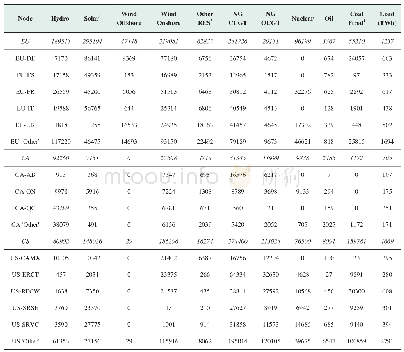《Table B1 Installed capacities (MW) and total load (TWh) 2050 EU-NAM reference model.‘Other’nodes ar
 提示:宽带有限、当前游客访问压缩模式
提示:宽带有限、当前游客访问压缩模式
本系列图表出处文件名:随高清版一同展现
《Developing a global interconnected power system model》
1 Includes hydro impoundment and hydro run of river,pumped hydro storage not incorporated in early-stage simulations.2 Includes concentrated solar power and solar-PV.3 Includes biomass and waste,geothermal,tidal and wave-based capacity.4 Also includes l
The starting point of developing the global grid power system model is an existing European electricity dispatch model with hourly temporal resolution(EU-281+Norway and Switzerland)as constructed for previous work on the implications of the potential future European power system[10].The European model(EU model)has been developed using a soft-linking approach to provide additional insights on the European Commission’s EU 2016 Reference Scenario(EU-REF)[35].The EU model consists of a single node per country.Furthermore,generator categories as constructed in PLEXOS?for the EU model,also follow EU-REF.A disaggregation approach has been used to convert aggregated overall capacities per power plant,per country,as given in EU-REF,into generator portfolios with standardized characteristics per generator unit.An overview of some of these characteristics can be found in Table 1.Localised hourly profiles for load and VRES are incorporated based on historical hourly data at country level.A carbon price of 88€/Tonne CO2 is incorporated following EU-REF.For more details on the methodology and data assumptions behind the EU model we refer to[10].
| 图表编号 | XD0020049800 严禁用于非法目的 |
|---|---|
| 绘制时间 | 2018.08.01 |
| 作者 | Maarten Brinkerink、Paul Deane、Seán Collins、Brian ó Gallachóir |
| 绘制单位 | MaREI Centre, Environmental Research Institute, University College Cork、School of Engineering, University College Cork、MaREI Centre, Environmental Research Institute, University College Cork、School of Engineering, University College Cork、MaREI Centre, Env |
| 更多格式 | 高清、无水印(增值服务) |





